
Mussel is the common name used for members of several families of bivalve molluscs, from saltwater and freshwater habitats. These groups have in common a shell whose outline is elongated and asymmetrical compared with other edible clams, which are often more or less rounded or oval.

Bivalvia or bivalves, in previous centuries referred to as the Lamellibranchiata and Pelecypoda, is a class of aquatic molluscs that have laterally compressed soft bodies enclosed by a calcified exoskeleton consisting of a hinged pair of half-shells known as valves. As a group, bivalves have no head and lack some typical molluscan organs such as the radula and the odontophore. Their gills have evolved into ctenidia, specialised organs for feeding and breathing.

The New Zealand pea crab, is a species of small, parasitic crab that lives most commonly inside New Zealand green-lipped mussels. Adult females are about the size and shape of a pea, while adult males are smaller and flatter. Adult New Zealand pea crabs are completely reliant on their host mussel for shelter and food, which it steals from the mussel's gills. The New Zealand pea crab is found throughout New Zealand and can infect up to 70% of natural populations. These crabs are of concern to green-lipped mussel aquaculture because they reduce the size and growth of mussels, although infected mussels can be harvested and consumed.
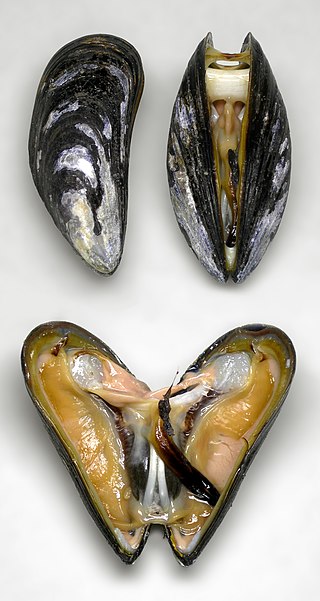
The blue mussel, also known as the common mussel, is a medium-sized edible marine bivalve mollusc in the family Mytilidae, the only extant family in the order Mytilida, known as "true mussels". Blue mussels are subject to commercial use and intensive aquaculture. A species with a large range, empty shells are commonly found on beaches around the world.
Perkinsus is a genus of alveolates in the phylum Perkinsozoa. The genus was erected in 1978 to better treat its type species, Perkinsus marinus, known formerly as Dermocystidium marinum. These are parasitic protozoans that infect molluscs, at least some of which cause disease and mass mortality. P. marinus is the most notorious, causing the disease perkinsosis, or dermo, in wild and farmed oysters.

The Pacific oyster, Japanese oyster, or Miyagi oyster is an oyster native to the Pacific coast of Asia. It has become an introduced species in North America, Australia, Europe, and New Zealand.
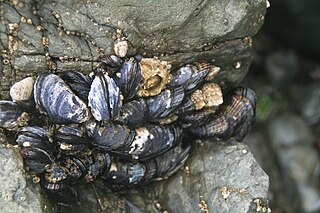
The California mussel is a large edible mussel, a marine bivalve mollusk in the family Mytilidae.

Crepidula fornicata is a species of medium-sized sea snail, a marine gastropod mollusc in the family Calyptraeidae, the slipper snails and cup and saucer snails. It has many common names, including common slipper shell, common Atlantic slippersnail, boat shell, quarterdeck shell, fornicating slipper snail, Atlantic slipper limpet and it is in Britain as the "common slipper limpet".
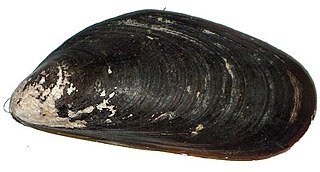
The Chilean mussel or Chilean blue mussel, Mytilus chilensis, is a species of blue mussel native to the coasts of Chile from Biobío Region to Cape Horn. Genomic evidence has confirmed that the native Chilean blue mussel is genetically distinct from the Northern Hemisphere M. edulis, M. galloprovincialis and M. trossulus and also genetically different from Mytilus platensis,the other species of smooth shelled mussel from South America.

Lajonkairia lajonkairii is an edible species of saltwater clam in the family Veneridae, the Venus clams.

Mytilus is a cosmopolitan genus of medium to large-sized edible, mainly saltwater mussels, marine bivalve molluscs in the family Mytilidae.
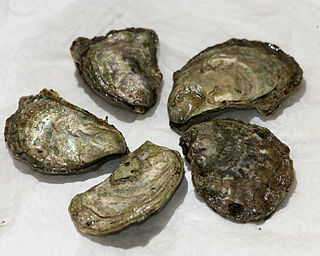
Ostrea lurida, common name the Olympia oyster, after Olympia, Washington in the Puget Sound area, is a species of small, edible oyster, a marine bivalve mollusk in the family Ostreidae. This species occurs on the northern Pacific coast of North America. Over the years the role of this edible species of oyster has been partly displaced by the cultivation of non-native edible oyster species.
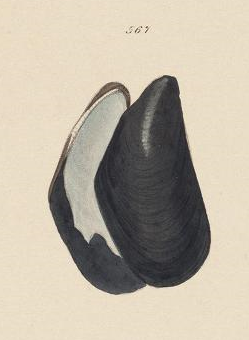
Mytilus trossulus, the Pacific blue mussel, bay mussel or foolish mussel, is a medium-sized edible marine bivalve mollusc in the family Mytilidae.
Marteilia is a protozoan genus of organisms that are parasites of bivalves. It causes QX disease in Sydney rock oysters and Aber disease in European flat oysters. After being infected by Marteilia, bivalves lose pigmentation in their visceral tissue, and become emaciated.
Edulis, edible in Latin, is a species name present in a number of Latin species names:

The Mediterranean mussel is a species of bivalve, a marine mollusc in the family Mytilidae. It is an invasive species in many parts of the world, and also an object of aquaculture.
Urastoma cyprinae is a turbellarian that infects the gills of numerous species. It has been reported as free-living organism in marine mud and on algae. Urastoma cyprinae is reported as an opportunistic mantle inhabitant on the gills of various bivalve species, including the clams Tridacna maxima and Tridacna gigas, and the mussels Mytilus edulis and Mytilus galloprovincialis. They are also found throughout the gill surface of C. virginica and is attracted by mucus that coats the gills of oysters. However, the nature of the host-parasite relationship remains unknown.
Bucephalus mytili is a parasitic flatworm of the class Trematoda. It is a parasite of fish and a parasitic castrator of the mussel Mytilus edulis, where it destroys the mussel's gonads and causes the mussel to grow much larger than normal.
Mytilicola intestinalis is an internal copepod parasite of mussels native to the Mediterranean and Adriatic Seas. It invaded the Wadden Sea in the 1930s and since then has slowly expanded its distribution throughout the Wadden Sea. This spread has been northward and towards the southwest. In these two separate expansions local adaptation has occurred.











